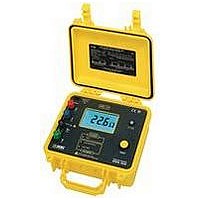4630 KIT-300FT AEMC, 4630 KIT-300FT Datasheet - Page 2

4630 KIT-300FT
Manufacturer Part Number
4630 KIT-300FT
Description
GROUND RESISTANCE TESTER KIT, 2000OHM
Manufacturer
AEMC
Datasheet
1.4630_KIT-300FT.pdf
(5 pages)
Specifications of 4630 KIT-300FT
Resistance Measuring Range
20/200/2000 Ohm
Resolution (ohm)
1ohm
Test Current
10mA
Accuracy
2% Of Rdg ± 3cts
External Height
247mm
External Width
273mm
External Depth
127mm
Weight
7.38lb
Lead Free Status / RoHS Status
na
Features
• M easures soil resistivity (4-Point)
•
•
•
•
•
•
•
•
•
•
•
•
•
•
method
M easures ground resistance (2- and
3-Point) Fall-of-Potential method
S tep voltage tests and touch
potential measurements
A uto-Ranging: automatically selects
the optimum resistance range
D esigned to reject high levels of
noise and interference
E xtremely simple to operate:
connect – press – read
L ED on faceplate informs operator of
high input noise, high auxiliary rod
resistance and fault connections
Large easy-to-read backlit display
B attery powered (Model 4620)
A C powered with rechargeable
NiMH batteries (Model 4630)
R ugged dustproof and rainproof
field case
C an also be used for continuity
tests on bonding
Color-coded terminals
D ouble Insulation
C E Mark
Technical Assistance (800) 343-1391
Applications
•
•
•
Three-Point measurements of
resistance to ground of ground
rods and grids. Three-Point mea-
surements are generally used when
the electrode or grid can be easily
disconnected, if corrosion is
suspected, or in circumstances where
ground faults are unlikely to occur.
Four-Point tests or soil resistivity
measurements. Locating areas of
lowest soil resistivity is essential for
achieving an economical grounding
installation.
Touch potential measurements, an
alternative to 3-Point tests in
evaluating electrical safety. This
test is recommended when the
ground cannot be disconnected,
where ground faults are highly likely
to occur, or when the “footprint” of
grounded equipment (the outline of
the part of equipment in contact with
the earth) is comparable to the size
of the ground to be tested.
•
Two-Point tests for continuity
tests on bonding or on
pre-established grounds.
This test is commonly performed in
urban environments where proper
auxiliary electrode placement may be
obscured by confined real estate.
Measurements are referenced
against a good local grounded circuit.
4620 & 4630_213043-213044 (pdf) 04/08 Rev. 03
www.aemc.com
2 of 5




